
T Aurigae was a nova, which lit up in the constellation Auriga in 1891. Thomas David Anderson, an amateur astronomer in Edinburgh, reported that he was "almost certain" he saw the nova at 02:00 UT on 24 January 1892, when it was slightly brighter than χ Aurigae. He mistook the star for 26 Aurigae, although he noted to himself that it seemed brighter than he remembered it being. He saw it twice more during the following week. On 31 January 1892 he realized his mistake, and wrote a note to Ralph Copeland reporting his discovery. Professor Copeland immediately reported the discovery via telegram to William Huggins, who made the first spectroscopic observations of T Aurigae on 2 February 1892, when the star was a magnitude 4.5 object. T Aurigae was the first nova to be observed spectroscopically.
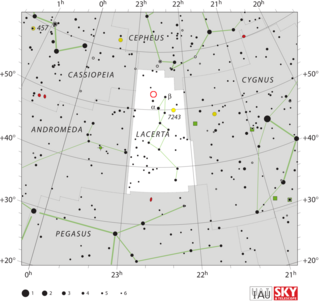
DI Lacertae or Nova Lacertae 1910 was a nova in constellation Lacerta which appeared in 1910. It was discovered by Thomas Henry Espinell Compton Espin at Wolsingham Observatory on 30 Dec 1910, at which time it was an 8th magnitude object. Subsequent examination of pre-discovery photographic plates showed that the outburst occurred sometime between 17 November 1910 and 23 November 1910. It reached a peak brightness of magnitude 4.6 on 26 November 1910, making it visible to the naked eye. Before the nova event DI Lacertae was a 14th magnitude star, and by 1950 it had returned to 14th magnitude.

BT Monocerotis was a nova, which lit up in the constellation Monoceros in 1939. It was discovered on a spectral plate by Fred L. Whipple on December 23, 1939. BT Monocerotis is believed to have reached mag 4.5, which would have made it visible to the naked eye, but that value is an extrapolation; the nova was not observed at peak brightness Its brightness decreased after the outbreak by 3 magnitudes in 182 days, making it a "slow nova". The light curve for the eruption had a long plateau period.

DK Lacertae was a nova, which lit up in the constellation Lacerta in 1950. The nova was discovered by Charles Bertaud of the Paris Observatory on a photographic plate taken on 23 January 1950. At the time of its discovery, it had an apparent magnitude of 6.1. DK Lacertae reached peak magnitude 5.0, making it easily visible to the naked eye.
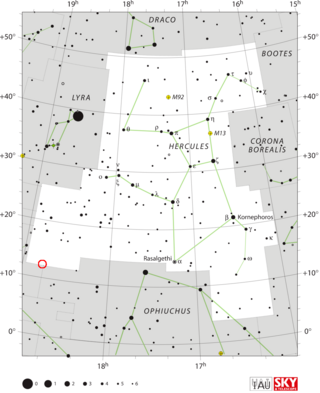
V838 Herculis, also known as Nova Herculis 1991, was a nova which occurred in the constellation Hercules in 1991. It was discovered by George Alcock of Yaxley, Cambridgeshire, England at 4:35 UT on the morning of 25 March 1991. He found it with 10×50 binoculars, and on that morning its apparent visual magnitude was 5. Palomar Sky Survey plates showed that before the outburst, the star was at photographic magnitude 20.6 and 18.25.
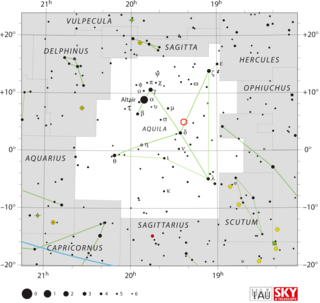
V1494 Aquilae or Nova Aquilae 1999 b was a nova which occurred during 1999 in the constellation Aquila and reached a brightness of magnitude 3.9 on 2 December 1999. making it easily visible to the naked eye. The nova was discovered with 14×100 binoculars by Alfredo Pereira of Cabo da Roca, Portugal at 18:50 UT on 1 December 1999, when it had a visual magnitude of 6.0.
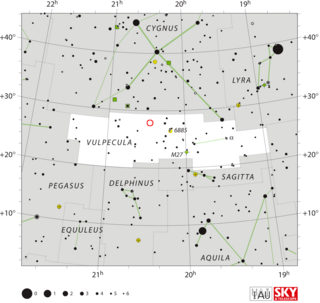
QU Vulpeculae, also known as Nova Vulpeculae 1984 Number 2, was the second nova which occurred in 1984 in the constellation Vulpecula. It was discovered by Peter Collins, an amateur astronomer from Cardiff, California at 22:08 UT on 22 December 1984. At the time of its discovery, the nova's apparent magnitude was 6.8. By the next night, Collins reported its brightness had increased to magnitude 5.6, making it visible to the naked eye.

RX Andromedae is a variable star in the constellation of Andromeda. Although it is classified as a dwarf nova of the Z Camelopardalis (UGZ) type, it has shown low-luminosity periods typical of VY Sculptoris stars. However, for most of the time it varies from an apparent visual magnitude of 15.1 at minimum brightness to a magnitude of 10.2 at maximum brightness, with a period of approximately 13 days.
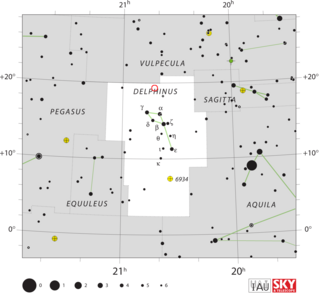
HR Delphini, also known as Nova Delphini 1967, was a nova which appeared in the constellation Delphinus in 1967. It was discovered by George Alcock at 22:35 UT on 8 July 1967, after searching the sky for over 800 hours with binoculars. At the time of discovery it had an apparent magnitude of 5.0. It reached a peak brightness of magnitude 3.5 on 13 December 1967, making it easily visible to the naked eye around that time. Pre-outburst photographs taken with the Samuel Oschin telescope showed it as a ~12th magnitude star which might have been variable.
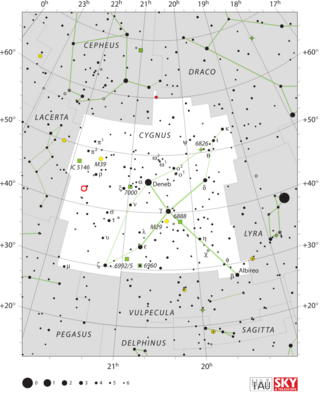
Q Cygni, is a star located in the constellation Cygnus. It is also known as Nova Cygni 1876, and has the designation NGC 7114, and HR 8296. Nova Cygni is located in the northwestern portion of Cygnus along the border with Lacerta.

PX Andromedae is an eclipsing cataclysmic variable star in the constellation Andromeda. It has been classified as a SW Sextantis variable, and its apparent visual magnitude varies between 14.04 and 17.

V1315 Aquilae is a cataclysmic variable star in the north of the equatorial constellation of Aquila. It is in the sub-set of nova-like (NL) variables, specifically a SW Sextantis star. These were characterized as having non-magnetic white dwarfs – thus that do not undergo dwarf-nova bright luminations ("eruptions"). There is countering evidence for some magnetism. Being a SW Sextantis star, V1315 Aquilae has a high rate of mass transfer, so it is in steady-state accretion and in a constant state of outburst. It emits most of its light in the visible range, and this comes from the accretion disk. The eclipse depth is 1.8 mag. No description of the donor star is made.

V630 Sagittarii was a nova visible to the naked eye in 1936. It was discovered on 3 October 1936 by Shigeki Okabayashi of Kobe, Japan when it had an apparent magnitude of 4.5.
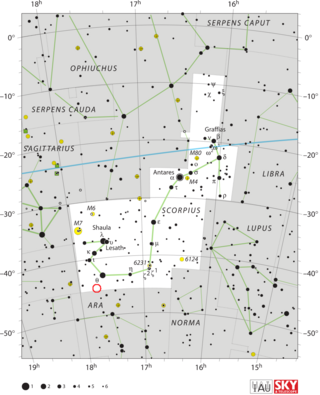
V728 Scorpii, also known as Nova Scorpii 1862, was a nova that occurred in the constellation of Scorpius. It was discovered on 4 October 1862 by John Tebbutt, an astronomer living in New South Wales, Australia, while he was observing a comet. He reported that the star was in the constellation Ara. At the time of its discovery, the nova had an apparent magnitude of 5, making it visible to the unaided eye. Nine days later it had faded to below 11th magnitude, indicating that it was a very fast nova.
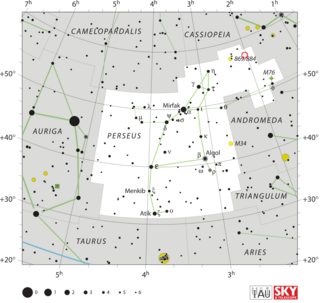
V Persei, also known as Nova Persei 1887 was discovered by Williamina Fleming on a Harvard College Observatory objective-prism photograph taken on 3 November 1887. It is believed to be the first nova whose spectrum was recorded. The nova had an apparent magnitude of 9.2 at the time of discovery. Judging from the consistency of the nova's brightness after discovery, and details of the spectral lines seen, McLaughlin estimated that the nova was five or six months past peak brightness at the time of its discovery, and at its peak it was almost certainly at least as bright as 4th magnitude. So V Persei was probably visible to the naked eye, though there is no record that anyone actually noticed it when that was possible. It is currently an 18th magnitude object.

V368 Aquilae, also known as Nova Aquilae 1936 no. 2 was the second nova which occurred in the constellation of Aquila during 1936. It was discovered on a photographic plate by Nils Tamm at Kvistaberg Observatory on 7 October 1936. At the time of discovery it was at photographic magnitude 7, and was already fading. Pre-discovery photographs showed that peak brightness occurred around 25 September 1936, at which time it had reached apparent magnitude 5.0, making it visible to the naked eye. The nova was described as being fiery red due to strong Hα emission, and for a time could be seen with binoculars simultaneously with V356 Aquilae, another nova which Nill Tamm had discovered a month earlier.
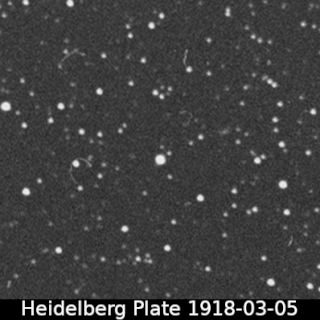
GI Monocerotis, also known as Nova Monocerotis 1918, was a nova that erupted in the constellation Monoceros during 1918. It was discovered by Max Wolf on a photographic plate taken at the Heidelberg Observatory on 4 February 1918. At the time of its discovery, it had a photographic magnitude of 8.5, and had already passed its peak brightness. A search of plates taken at the Harvard College Observatory showed that it had a photographic magnitude of 5.4 on 1 January 1918, so it would have been visible to the naked eye around that time. By March 1918 it had dropped to ninth or tenth magnitude. By November 1920 it was a little fainter than 15th magnitude.

WY Sagittae, also known as Nova Sagittae 1783, is a star in the constellation Sagitta which had a nova eruption visible in 1783. It was discovered on 26 July 1783 by the French astronomer Joseph Lepaute D'Agelet. It is usually difficult to precisely identify novae that were discovered hundreds of years ago, because the positions were often vaguely reported and historically there was not a clear distinction drawn between different sorts of transient astronomical events such as novae and comet apparitions. However D'Agelet observed this nova with a mural quadrant, which produced coordinates accurate enough to allow modern astronomers to identify the star. D'Agelet reported the apparent magnitude of the star as 6, but Benjamin Apthorp Gould, who analysed D'Agelet's records, determined that what D'Agelet called magnitude 6 corresponds to magnitude 5.4 ± 0.4 on the modern magnitude scale, so the nova was visible to the naked eye.

V1370 Aquilae, also known as Nova Aquilae 1982, is a nova that appeared in the constellation Aquila during 1982. It was discovered by Minoru Honda of Kurashiki, Japan at 20:30 UT on 27 January 1982. At that time the Sun had moved just far enough from Aquila to allow the nova to be seen in the morning sky. Although it was discovered photographically, its apparent magnitude was 6–7, making it potentially visible to the naked eye under ideal conditions. A possible magnitude 20 progenitor was located on the Palomar Sky Survey prints. Spectra of the object were taken in February 1982 at Asiago Astrophysical Observatory, which confirmed that it is a nova.

OY Arae, also known as Nova Arae 1910, is a nova in the constellation Ara. It was discovered by Williamina Fleming on a Harvard Observatory photographic plate taken on April 4, 1910. At that time it had a magnitude of 6.0, making it faintly visible to the naked eye under ideal observing conditions. Examination of earlier plates showed that before the outburst it was a magnitude 17.5 object, and by March 19, 1910, it had reached magnitude 12.





















